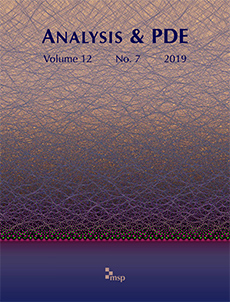Abstract
This work extends monotonicity-based methods in inverse problems to the case of the Helmholtz (or stationary Schrödinger) equation in a bounded domain for fixed nonresonance frequency and real-valued scattering coefficient function . We show a monotonicity relation between the scattering coefficient and the local Neumann-to-Dirichlet operator that holds up to finitely many eigenvalues. Combining this with the method of localized potentials, or Runge approximation, adapted to the case where finitely many constraints are present, we derive a constructive monotonicity-based characterization of scatterers from partial boundary data. We also obtain the local uniqueness result that two coefficient functions and can be distinguished by partial boundary data if there is a neighborhood of the boundary part where and .
Citation
Bastian Harrach. Valter Pohjola. Mikko Salo. "Monotonicity and local uniqueness for the Helmholtz equation." Anal. PDE 12 (7) 1741 - 1771, 2019. https://doi.org/10.2140/apde.2019.12.1741
Information





